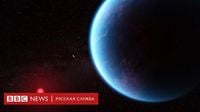In a groundbreaking discovery, astronomers from the University of Cambridge have identified possible signs of extraterrestrial life on the exoplanet K2-18b. Using the powerful James Webb Space Telescope (JWST), the research team detected molecules in the planet's atmosphere that on Earth can only be produced by simple organisms. This development marks the second instance of potential life-related chemicals being found in a planet's atmosphere through JWST observations, with this latest finding deemed more promising than the previous one.
Located in the constellation Leo, K2-18b orbits its star at a distance of 124 light-years from Earth and is approximately two and a half times larger than our planet. Professor Nikku Madhusudhan, the lead researcher from the Institute of Astronomy at the University of Cambridge, expressed optimism about the implications of their findings. "This is the most convincing evidence we currently have that somewhere out there, there might be life. I can realistically say that we will be able to confirm this evidence within a year or two," he stated.
During their observations, the Cambridge team discovered traces of organic compounds in the atmosphere of K2-18b, specifically dimethyl sulfide and dimethyl disulfide. On Earth, these gases are produced by marine bacteria and phytoplankton. Madhusudhan noted that the concentration of these gases in K2-18b's atmosphere is thousands of times higher than similar levels found on Earth. "If the connection between these gases and life is real, then this planet is teeming with life," he concluded.
However, the researchers are cautious, acknowledging that many uncertainties still exist. The latest observation does not yet meet the rigorous standards required for a definitive scientific discovery. To classify a result as scientifically valid, scientists must be approximately 99.99999% certain it reflects reality rather than an error, a threshold known as a five-sigma level result. The current findings have a statistical significance of three sigma, indicating a 99.7% certainty that the results are not coincidental.
Professor Katrin Heimans from the University of Edinburgh, who also serves as the Royal Astronomer of Scotland, highlighted the need for caution. "Even with such a level of certainty, the origin of this gas would still be in question," she explained. Heimans emphasized that while the gases on Earth are produced by microorganisms in the ocean, it remains uncertain whether the gases on K2-18b are of biological origin. The universe is filled with strange phenomena, and geological processes on the distant planet could also lead to the formation of such molecules.
In light of these uncertainties, the Cambridge team is collaborating with various research groups to explore how dimethyl sulfide and dimethyl disulfide could be produced in the absence of living organisms. Additionally, researchers are investigating alternative explanations for the presence of these compounds on K2-18b.
Debates surrounding the structure of K2-18b itself also persist. Some scientists hypothesize that the planet may possess a vast ocean, inferred from the absence of ammonia in its atmosphere, suggesting that it may be absorbed by a large body of water. However, Professor Oliver Shorttle from Cambridge posited that the lack of ammonia could also indicate a molten rock ocean, which would eliminate the possibility of life.
Meanwhile, Nicholas Vaughan from NASA's Ames Research Center offered a different perspective, suggesting that K2-18b could be a mini gas giant without a solid surface. This interpretation, however, is contested by other researchers who argue that it contradicts the data obtained from the JWST, underscoring the complexity of the scientific discourse surrounding K2-18b.
Despite the challenges, Professor Madhusudhan remains hopeful. He believes that confirming life on K2-18b could represent a pivotal moment in humanity's quest to understand its place in the universe. "This could be a turning point, when the fundamental question of whether we are alone in the universe suddenly becomes one we can answer," he remarked.
The research findings have been published in the prestigious journal The Astrophysical Journal Letters. As the scientific community continues to analyze these results, researchers are planning further observations to confirm or refute the presence of dimethyl sulfide and dimethyl disulfide in K2-18b's atmosphere.
In a related note, astronomers caution against jumping to conclusions about extraterrestrial life. Madhusudhan himself urged restraint, stating, "It's not beneficial for anyone to prematurely claim we have discovered life." He suggests that the most plausible explanation for the observations is the existence of a warm ocean filled with life on K2-18b.
As excitement builds around the potential for life beyond Earth, the scientific community remains vigilant. While the discovery of molecules associated with life is thrilling, experts like planetary scientist Steven Schmidt from Johns Hopkins University remind us that it is merely a hint, not definitive proof. Schmidt stated, "This is not trivial; it's a suggestion. But we cannot assert that the planet is habitable yet."
Astrobiologist Christopher Glein from the Southwest Research Institute added a touch of humor to the discourse, stating, "If we don't see an alien waving at us, then there won't be convincing evidence." Nonetheless, the ongoing research into K2-18b continues to captivate scientists and enthusiasts alike, as they seek to unravel the mysteries of this intriguing exoplanet.
In conclusion, K2-18b represents a tantalizing possibility in the search for extraterrestrial life. With ongoing studies and further observations planned, the scientific community is poised to explore the depths of this distant world, hoping to uncover the secrets it may hold.





